I follow the lead of Jorge Luis Borges: a few metaphors, but resonant ones: a library, a labyrinth, a map, a mirror. Most importantly, the mirror. Certainly the mirror came first, as there was water for Narcissus to gaze in before Daedalus built his labyrinth, or the fatal wings. In front of a mirror I take for granted the difficulty of specifying within any system of signification which version is the original, which the reflection, although I might feel that I can tell the difference. Mirrors are difficult to write about. Let the reader beware.
As if I were trapped between mirrors, I seem to oscillate between two images. The first is a photographic work in daguerreotype made by Jerry Spagnoli. A photographic artist in his own right, he also makes daguerreotypes with Chuck Close. More than 150 years ago, Oliver Wendell Holmes called the medium “a mirror with a memory.” The daguerreotype is a thin slab of silver-coated metal that when sensitised acts like a piece of positive film. Can a mirror remember? Can it forget? The image I have in mind is one of catastrophe, a plate Spagnoli made hastily from a rooftop during the collapse of the World Trade Centre. The image bears an almost hallucinogenic clarity, the result of its reflective surface actually bouncing light back up through the exposed silver grains. I see the event in such mobile particularity that it’s as if it were replaying itself all over again, cancelling out an archive of images. And I see something else. Because a daguerreotype must be angled just so for the image to appear amidst all the light bouncing off the plate, I must tip it back and forth. When the disaster image disappears, it is replaced by the reflection of my peering gaze, and everything behind me: my books, an open window, more light, the world. A world still here, but changed irrevocably by what that image captured.

Jerry Spagnoli
Untitled (From the series The Last Great Daguerreuan Survey of the Twentieth Century) 11 September 2001
Oil on canvas
318 x 276 cm
Courtesy the artist © Jerry Spagnoli
The other image, the brother image, does not yet exist. It is part of a proposed installation by the Italian artist Silvio Wolf. This installation involves a horizontal series of black photographs arranged along a corridor, imageless squares that float over illuminated backgrounds. Light seems to emanate from behind the black squares, but they themselves remain resolutely dark. When a viewer approaches these works (I imagine), they seem to suck vision directly from his eyes. It’s as if the world itself were wearing dark glasses. If I manage to catch a glimpse of anything in the dark surface, it’s only my fleeting image.
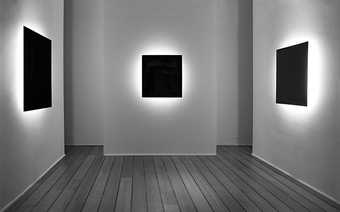
Proposed installation view of Silvio Wolf’s Meditations 2009
Courtesy the artist and Nicolette Rusconi Gallery © Silvio Wolf
These are the mirror’s two poles: the multiplication of being through a plenitude of representations: or the negation of that power through the creation of an impossible void in the space of representation, a reflective abyss. Each type of mirror has its history, its proponents, its victims. With the generative, populating mirror and its problems – of identity, illusion, narcissism – we are intimately familiar. Plato equates such visions with the shadows on a cave wall, copies of copies whose original, singular, non-material, non-visual form is the ultimate goal of knowledge. Instead we never leave the realm of illusory representation. The history of Western art, then, implies the mirror in its basic theoretical framework, that of mimesis, of imitation, and it carried with it a normative, even pejorative cast. Theorists from Freud to René Girard to Jacques Lacan have argued that imitation and the mirror have an even more fundamental role – for Freud in the narcissistic personality and for Lacan in ego formation through what he calls the mirror stage of development. Lacan remarks in one of his lectures that the fragmented, primitive consciousness of a child gains integrity through a prolonged, fascinated gaze in the “mirror” of a unified order. The fascination involves both terror and desire. For Girard, imitative or mimetic behaviour is the source of culture itself, and its violent birth takes place in acts of ritual sacrifice and scapegoating.
In the Christian West of the late Middle Ages, the mirror had a double character. It still stood for vanity, but it also signalled the world’s increasing availability to Western observation, a widening domain of representation fostered by burgeoning commercial activity. The artist was the one who trafficked these signs. In Jan van Eyck’s fifteenth-century painting of the Arnolfini marriage, for example, a convex mirror is the focal point. Two tiny figures can be seen reflected in it as they cross the threshold of the room. They are probably the painter himself and a young man, perhaps arriving to act as witnesses to the marriage. The convex mirror is able to absorb and reflect in a single image both the floor and the ceiling, as well as the sky and the garden outside, which are otherwise all but invisible through the side window. Some commentators have said that the mirror thus acts as a sort of hole sucking the entire visual world into itself, transforming it into a representation. More accurately, the mirror (art in its metaphoric guise) expands the territory of the visible beyond what the individual can directly experience. The expansion and complication of the visual is a theme taken up repeatedly by Mannerist and Baroque artists, from Parmigianino to Velázquez, most notably in Las Meninas 1656–7.

Diego Velázquez
Las Menias 1656–7
Oil on canvas
318 x 276 cm
Courtesy Prado, Madrid / the Bridgeman Art Library
It is not difficult to see how such themes become politicised in the nineteenth century – and parodied in the twentieth. In Manet’s celebrated cultural panorama A Bar at the Folies-Bergère 1882, the fixed perspective of the artist and the supposed transparency of his vision has yielded to a more ambiguous and compromising position for the viewer. The barmaid poses before us, somewhat abstracted, not looking precisely at us. The wide mirror behind her reflects her back, off centre, and the crowd she serves (of a class to which she does not belong – the looking class, we might call it). We have visual access to all of her, but we can’t view the customers directly because, of course, we are among them, and our desiring, possessive gaze defines the centre of the picture.
The American Pop painter Mel Ramos encapsulated the entire tradition of the mirrored gaze, with its psychological, sexual and political overtones, in a 1974 parody of another Velázquez painting, Venus and Cupid. (He also parodied Manet’s Olympia.) His odalisque is a blond-haired, airbrushed movie star, looking at her culturally manufactured image in a mirror while watched by a monkey. Her gaze is directed at the mirror, but the expression on her reflected face makes it clear who she’s really looking at. She gives us just what we were looking for.
Only a few years after Ramos’s painting appeared, Canadian Jeff Wall was thinking in a very different vein about the mirroring problems posed by Velázquez and Manet when he constructed the first of his photographic tableaux. His Picture for Women 1979 is a self-conscious attempt to undo the relationships of the Folies-Bergère by placing the photographer and his subject in the same visual plane, collapsing both “sides” of the picture plane into one transparent surface and making the centre of the photograph the camera itself, which is pointed at us. However we interpret this image – as a deliberately feminist statement or a game of confusing the viewer’s eye – it constituted an emphatic announcement that the arena for exploring the problematic relation of representation, the body and the subjective gaze had shifted from painting to photography.
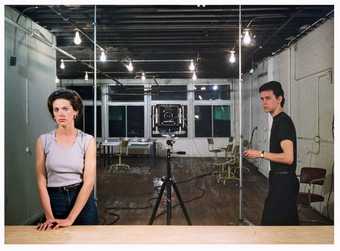
Jeff Wall
Picture for Women 1979
Transparency in Lightbox
142.5 x 204.5 cm
Courtesy White Cube Gallery, London © Jeff Wall
The shift was inevitable. Because photography is a mechanical process contingent on the refraction of light and its capture - and depending on the camera, dependent on mirrors as well to reverse the image to its “normal” orientation – its unavoidable subject cannot be the artist and his expressiveness, but must be representation itself, the peculiar relationship between things seen and things “seen” photographically. This is, after all, the source of the medium’s fascination. No wonder then that the medium is so self-reflexive, that there are so many doubles in photography, so many telltale signs of the photographer, from shadows to explicit self-portraits, so many mirror images. The best of the oeuvre of photographer Lee Friedlander, for example, contains almost nothing but reflections: in car mirrors, shop windows, television screens, car bumpers. In Friedlander’s work the camera captures the increasing artifactness of American society through the proliferation of representations, many generated by cameras and disseminated by television sets, the instruments of “culture”. It is no accident that at the same time Friedlander was at his peak, Robert Smithson organised his Yucatan Mirror Displacements 1969, an installation of mirrors placed in locations in Mexico, and photographed. The mirrors displaced little except the representation of their surroundings, with their reflections. The “displacement” took place not in the landscape, but in the camera.
For Plato this total mediation of reality by images, reality experienced at second or third hand, would constitute the ultimate cave of shadows. I remember a photograph I once saw of a man standing in a mirrored bathroom taking a photograph – obviously the picture I was looking at. His image was reflected to infinity in the mirrors around him. This level of reflexivity, this sense of inundation by images and of the complete inauthenticity of experience had produced a Samuel Beckett-like sense of irony in artists such as Vik Muniz, who finds myriad ways to undercut photography’s mirroring power without quite banishing its mimetic fascination. In Penelope Umbrico, it has provoked an insightful critical reaction. Her series For Sale/TVs from Craigslist 2008–9 features appropriated images of televisions for sale on the popular internet site, each of which contains a telltale reflection of the room in which it was photographed. Turned off, the sets continue to communicate unintended information in their very blankness. Umbrico reinserts them into the commercial nexus by selling the photographs on Craigslist as if they were TV sets, for their original internet prices.
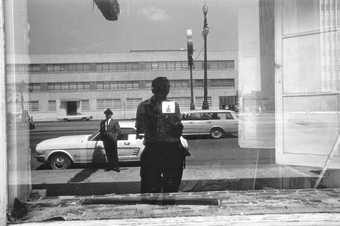
Lee Friedlander
New Orleans, Louisiana 1968
Gelatin silver print
27.9 x 35.5 cm
Courtesy Fraenkel Gallery, San Francisco © Lee Friedlander
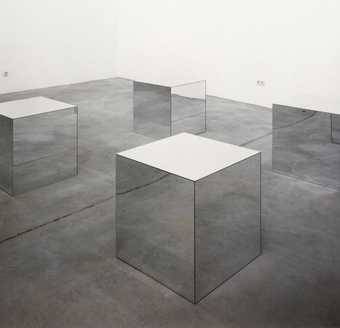
Robert Morris
Untitled (Mirrored Cubes) 1965/1971
Mirror plate, glass and wood
91.4 x 91.4 x 91.4 cm
Courtesy the artist and Spruth Magers Berlin London. Tate © Robert Morris/ ARS, NY and DACS, London 2010
For some of the most radical artists of our day, the expanding multiplications of the mirror have suggested ways to transcend the endgame they represent. We might call them artists of the dark mirror, as does art historian Arnaud Maillet. In the Mirror series, comprising some 50 paintings made in the late 1960s and early 1970s, Roy Lichtenstein simply leached out the power of representation and generation from the mirror by making it blank or covering it with his signature Benday dots. What are negated in this work are not only the image and the correspondence between a thing and its reflection/representation, but also the viewer. Our position is not implied, it is confronted. If we see ourselves as represented in any way, it is as mere dots, as a dispersed body in an empty field. And just as Jan van Eyck put himself in the mirror as an assertion of the artist’s priority in the chain of significations, Lichtenstein removes him.
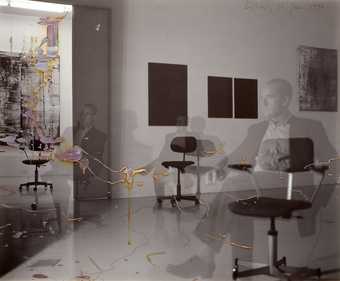
Gerhard Richter
Self Portrait, Three Times 1990
Oil on photographic paper
50.8 x 60 cm
Courtesy Marian Goodman Gallery, New York © Gerhard Richter
Gerhard Richter’s series of paintings called Spiegel, grau (Grey Mirror), produced in the late 1980s and early 1990s, seems to take Lichtenstein’s terminus ad quem as a starting point. These works “submerge the gaze in darkness and indeterminacy” , as Maillet puts it. Richter is well-known for basing much of his work on photographs, rather than on life (in spite of what many viewers take for their life-likeness). This approach relieved him of the burden of precision and gave to his paintings a quality of being “once removed” – removed from pre-existing reality and from the artist, both of which together are presumed to constitute the source of meaning in art. Art cannot deliver us from this true tyranny of its own appearances, the tyranny that points us towards a Platonic search for the origins of some singular truth outside ourselves. Nor can art fully liberate us to the pleasure of looking and to the diversity of feelings that should be its province. Instead, as in the Grey Mirrors, it can offer a kind of empty mirror, not a monochrome that resists our interpretive gaze, but a surface that swallows it up and gives back an indistinct image of ourselves – grey.
